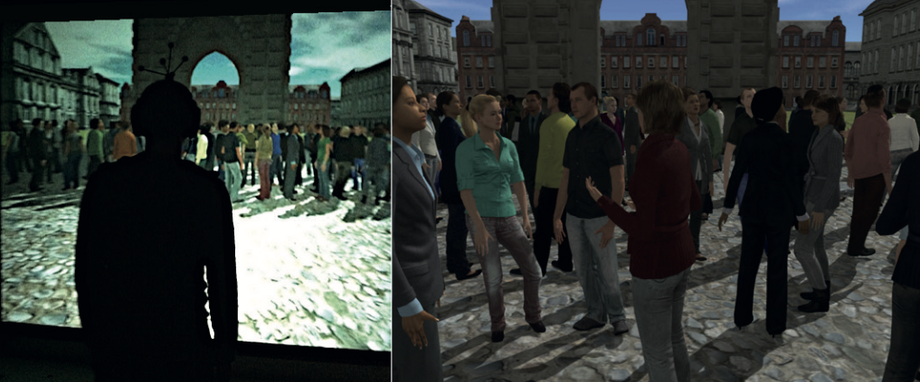Au cours des vingt dernières années, de nouveaux types de thérapie par exposition ayant recours aux technologies de réalité virtuelle se sont développés pour le traitement et la réhabilitation des troubles émotionnels, et notamment des phobies. La réalité virtuelle (RV) offre un contrôle très riche de la présentation sensorielle et spatiale des stimulations ce qui permet de mieux contrôler l’impact émotionnel des situations anxiogènes auxquelles le patient est exposé. Cependant, afin d’exploiter ces avantages uniques de la RV, il est nécessaire d’approfondir les connaissances sur les liens entre les caractéristiques de présentation des stimuli et leur effet émotionnel.
Nous avons exploré ces liens dans le cadre de foules virtuelles. La peur de la foule est un symptôme retrouvé dans plusieurs troubles émotionnels (agoraphobie, phobie sociale, peur de tomber...) et présente des composantes à la fois sensorielles (auditives et visuelles) et spatiales, ce qui fait de la foule un stimulus idéal pour nos études.
Une étude a été menée sur deux groupes de participants (sensibles ou non à la peur de la foule), immergés dans un environnement visuo-auditif contenant des foules virtuelles, et qui devaient indiquer l’intensité de leur inconfort. La présentation sensorielle des foules était soit visuelle, soit auditive, soit visuelle et auditive. Les résultats indiquent que la présentation visuo-auditive amplifie le ressenti négatif chez les participants sensibles à la peur de la foule. Cependant, cet effet n’est observé que lorsque la foule est proche du participant.
Ce résultat révèle l’interaction des caractéristiques spatiale et sensorielle du stimulus anxiogène sur l’impact émotionnel. Cette dépendance spatiale a motivé l’initiation d’un volet de recherches consacrées à l’étude de l’espace péri-personnel. L’homme ne perçoit pas l’espace de manière homogène : le cerveau code l’espace proche du corps différemment de l’espace lointain. L’espace péri-personnel (proche du corps) est codé par des neurones multisensoriels. Nous cherchons à mettre en évidence la plasticité des limites de cet espace en fonction de la nature du son et du contexte émotionnel ou social.
Équipe Ircam : Espaces acoustiques et cognitifs
 Dispositif de RV dans le studio 4 de l’Ircam. La stéréo visuelle est projetée sur un grand écran. La mise à jour des informations visuelles et auditives est réalisée grâce à un système de suivi de position
Dispositif de RV dans le studio 4 de l’Ircam. La stéréo visuelle est projetée sur un grand écran. La mise à jour des informations visuelles et auditives est réalisée grâce à un système de suivi de position







